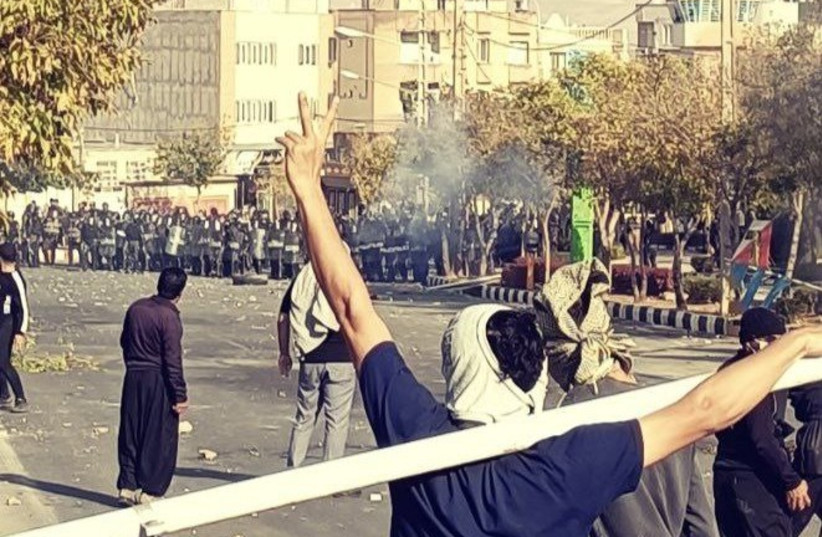The commander-in-chief of the Islamic Revolutionary Guard Corps (IRGC) Hossein Salami stated that the protests sparked after the murder of Mahsa Amini by Tehran's "morality police" were "the strongest, most dangerous, and most serious" such protests in Iran during a conference of Basij officials on Tuesday.
Salami additionally referred to the protests as "the most unequal and broadest global fight against Iran's Islamic system," claiming that "the enemy was defeated in this heavy fight," according to the IRGC-affiliated Tasnim News Agency.
"Basij and IRGC personnel entered the field in the great sedition of the previous year with planning, steady steps, high self-confidence, and high hopes, and together with the people, they defeated it by foiling the enemy's plans," said Salami.
The IRGC commander also accused "the enemy" (usually a reference to the US and Israel) of planning to spark new protests on the anniversary of Amini's death.

Nationwide protests were sparked by Mahsa Amini's death last year
Amini’s death in September 2022 sparked nationwide protests that swept across Iran for months, only declining in January. Protests have periodically renewed in several locations in the months since then after a number of arrested protesters were executed and after Amini’s grave was vandalized.
Last month, Iran’s police force announced that it would be returning “morality police” patrols to the streets to enforce hijab laws, after about half a year in which the operations of the force were replaced with cameras and other technological measures.
The IRGC and Basij were central in suppressing protesters, with documents leaked by the GhyamSarnegouni ("Rise to Overthrow") dissident hacker group in June showing that Iranian President Ebrahim Raisi pushed to provide the IRGC with over $6 billion in support amid the protests.
In December, the Black Reward hacktivist group leaked a special bulletin prepared by media experts for the IRGC's commander-in-chief that included a warning by Gholam-Ali Haddad-Adel, a member of the Expediency Discernment Council, to Iranian Supreme Leader Ali Khamenei that "the Basij has weakened and has no ability to mobilize."
The bulletin also cited "some experts" as saying that there is an "accumulation of doubts and uncertainty" among the "revolutionary forces." Additionally, the bulletin noted that the protest movement "considers the greatest achievement of the recent riots to be the loss of people's fear of the military and police forces."
While some Iranian officials downplayed the severity of the protests, others warned that the situation was more serious than past protests.
In December, Mohammad Sadr, a member of Iran's Expediency Council which advises Iran's supreme leader, warned that while the protests have largely avoided economic slogans, the deteriorating economic situation in Iran could spark economic protests "which is very dangerous," in an interview with the Iranian Donya-e-Eqtesad newspaper.
"One hundred percent of the demands of the protesters are not impractical, and we can implement some of these demands over time to de-complex a little and move towards a peaceful country. If we don't use this method, we will be forced to continue the previous security methods that even if these protests seem to be reduced or collected, will still remain in the heart of society, youth, and political figures and will continue to resurface," warned Sadr at the time.
Additionally, the Iranian Students' News Agency (ISNA) published an article in October, a month after the protests began, focusing on a paper written by Iranian academics earlier in 2022 warning that economic and social change were becoming the main drivers of protests and that the behavior of protesters was drastically changing.
The academics noted that, since economic and anti-hijab law protests in 2017, protests have erupted spontaneously lacking any clear leadership and organized over social media.
"With the emergence of today's complicated and confusing conditions, discriminations and inequalities, and fear of unknown futures, the 'inner self' has awakened them and warned them to protest and demand for a better life," wrote the researchers.
"From this historical moment in Iran, something is happening that little by little breaks the previous political taboos governing the atmosphere of the society and brings different classes to the streets under different pretexts, and of course, most prominently, to protest against economic inequalities, unemployment, and corruption, without relying on an institution or organization as an intermediary between themselves and the government."
The researchers pointed out that in the protests since 2017 there had been an "almost unprecedented breaking of taboos in slogans, confrontations with the government, and an increase in radicalism with the acceptance of relatively high political and financial costs to achieve the goals."
The academics additionally stressed that the protests that began in 2017 have continued until today and "have not stopped in any way," adding that the protests have spread to multiple groups in Iranian society.
The researchers warned that officials should consider the interests and demands of the protesters because "a spark is enough for all the protestors with their many and diverse attitudes and goals to pour into the streets and these movements will turn into small and big riots."
The academics also suggested that the government make protest movements official and create a "free and open political arena and mechanism to express protests."
